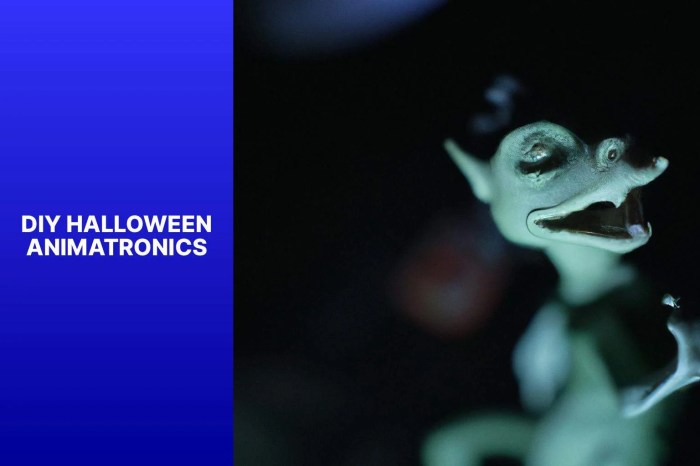DIY Halloween animatronics – the mere mention of it conjures up images of eerie, moving creatures that bring the spirit of Halloween to life. Whether you’re a seasoned tinkerer or a curious beginner, the allure of creating your own animatronics is undeniable. It’s a chance to unleash your creativity, combine technology with artistry, and transform your Halloween decorations into interactive experiences.
The world of DIY Halloween animatronics offers a vast playground for your imagination. From the classic ghoul lurking in the shadows to the whimsical pumpkin that winks and talks, the possibilities are endless. This guide will take you through the process of building your own animatronics, from selecting the perfect project to adding the finishing touches that bring them to life.
Integrating Sound and Lighting: Diy Halloween Animatronics

Adding sound effects and lighting to your DIY animatronics can significantly enhance their realism and create a truly immersive Halloween experience. By strategically incorporating these elements, you can transform your creations into captivating and terrifying figures.
Sound Effects for Realistic Ambiance, Diy halloween animatronics
Sound effects play a crucial role in bringing your animatronics to life. By adding appropriate sounds, you can create a sense of movement, emotion, and even danger.
- Movement Sounds: Use sounds like creaking, grinding, and rattling to mimic the movement of your animatronic. These sounds can be triggered by the animatronic’s actions, such as opening its mouth or moving its limbs.
- Breathing Sounds: Simulating breathing can add a sense of realism and even make your animatronic seem more alive. You can use recordings of human breathing or create your own sounds using software.
- Vocalizations: Incorporating voice sounds can be incredibly effective. You can use recordings of human voices, animal noises, or even create your own unique sounds.
- Environmental Sounds: Adding ambient sounds like wind, rain, or distant screams can enhance the overall atmosphere and create a more immersive experience.
Lighting to Enhance Appearance and Atmosphere
Lighting can dramatically impact the appearance of your animatronics and create a specific atmosphere. Strategic lighting can accentuate features, create shadows, and even evoke emotions.
- Accent Lighting: Use spotlights or other focused lights to highlight key features of your animatronics, such as their eyes, teeth, or claws. This can draw attention to specific areas and make them appear more prominent.
- Shadow Play: Create shadows using strategically placed lights to add depth and mystery to your animatronics. Shadows can make them appear larger, more menacing, or even distorted.
- Color Temperature: Consider the color temperature of your lighting. Cool blue tones can create a cold and eerie atmosphere, while warm orange or red tones can create a more sinister and threatening feel.
- Strobe Lights: Use strobe lights to create a disorienting and unsettling effect. Strobe lights can be used to highlight specific movements or create a sense of chaos.
Building DIY Halloween animatronics is a rewarding journey that blends technical skills with artistic vision. From the initial spark of an idea to the final unveiling of your creation, the process is filled with challenges and triumphs. As you delve into the world of animatronics, you’ll discover a sense of accomplishment, a unique blend of creativity and engineering, and the thrill of bringing your spooky visions to life. So, gather your tools, unleash your imagination, and let the haunting fun begin!
DIY Halloween animatronics are a fun and challenging way to bring your spooky decor to life. You can use a variety of materials, from cardboard and foam to motors and electronics, to create your own unique creatures. If you’re looking for a more realistic look, consider using a substance like pilocarpine , which can be used to create realistic eye effects.
With a little creativity and ingenuity, you can build your own animatronic masterpieces that will scare and delight your guests.
